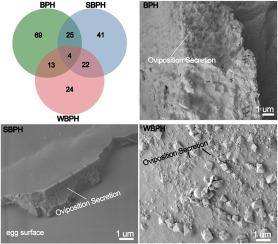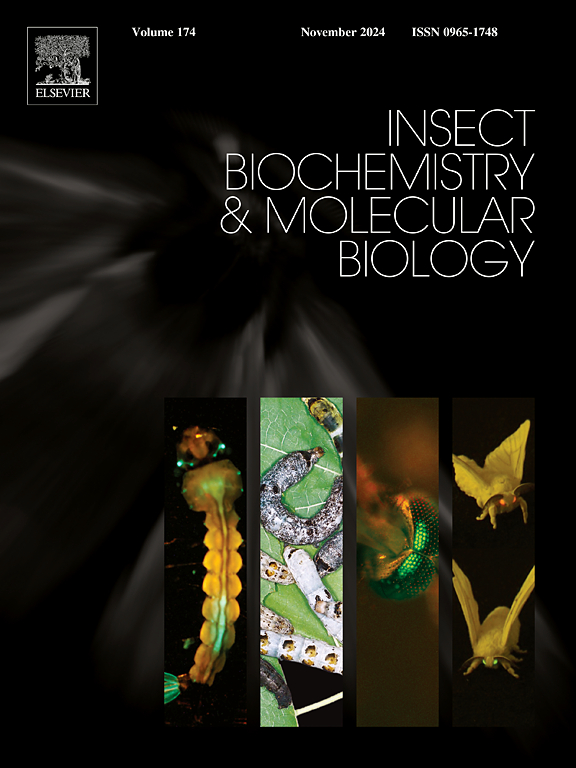Structural characterization and proteomic profiling of oviposition secretions across three rice planthopper species
IF 3.2
2区 农林科学
Q2 BIOCHEMISTRY & MOLECULAR BIOLOGY
引用次数: 0
Abstract
Insect oviposition secretions play crucial roles during the reproductive process, yet systematic studies on their structural characterization and protein compositions remain limited. This study investigated the oviposition secretions of three major rice pests: the brown planthopper (Nilaparvata lugens, BPH), small brown planthopper (Laodelphax striatella, SBPH), and white-backed planthopper (Sogatella furcifera, WBPH). Ultrastructural observation revealed differences in the oviposition secretions of them. The eggs of BPH and SBPH were adhered to rice tissue by abundant secretions, while WBPH eggs were embedded deeper within the leaf sheath with less secretions. Proteomic analysis identified 111, 98, and 66 oviposition secretion proteins (OSPs) in BPH, SBPH, and WBPH, respectively. 4 common protein subgroups were shared among them, along with varying numbers of shared subgroups between species pairs. Notably, the majority of OSPs were exclusively found in one species, indicating the existence of both similar and specialized functions unique to each planthopper species. The functions of 4 uncharacterized OSPs (Nl.chr07.0363, Nl.chr12.078, Nl.chr11.716, Nl.scaffold.0714) that were uniquely identified in the BPH were studied by maternal RNAi. Downregulation of each of these 4 protein-coding genes led to a significant decrease in egg production and hatchability. Moreover, knockdown of Nl.chr12.078 or Nl.chr07.0363 also disrupt the secretory function of the lateral oviduct. In conclusion, this study provides insights into the structural characteristics and protein components of the oviposition secretions of BPH, SBPH, and WBPH, which could serve as potential targets for RNAi-based pest control and lay a foundation for future studies on insect-plant interactions mediated by oviposition secretions.

三种稻飞虱产卵分泌物的结构特征和蛋白质组分析
昆虫的产卵分泌物在繁殖过程中起着至关重要的作用,但对其结构特征和蛋白质组成的系统研究仍然有限。本研究调查了三种主要水稻害虫的产卵分泌物:褐跳甲(Nilaparvata lugens,BPH)、小褐跳甲(Laodelphax striatella,SBPH)和白背跳甲(Sogatella furcifera,WBPH)。超微结构观察发现了它们产卵分泌物的差异。BPH和SBPH的卵被大量分泌物粘附在水稻组织上,而WBPH的卵则深埋在叶鞘中,分泌物较少。蛋白质组分析在 BPH、SBPH 和 WBPH 中分别发现了 111、98 和 66 个产卵分泌蛋白(OSPs)。它们之间共有 4 个共同的蛋白质亚群,物种对之间也有不同数量的共同亚群。值得注意的是,大多数 OSPs 只存在于一个物种中,这表明每个跳虫物种既有相似的功能,也有其特有的功能。研究人员通过母体 RNAi 研究了 4 个未表征的 OSPs(Nl.chr07.0363、Nl.chr12.078、Nl.chr11.716 和 Nl.scaffold.0714)的功能,这 4 个 OSPs 是在 BPH 中唯一发现的。下调这4个蛋白编码基因会导致产卵量和孵化率显著下降。此外,敲除Nl.chr12.078或Nl.chr07.0363也会破坏侧输卵管的分泌功能。总之,本研究深入揭示了BPH、SBPH和WBPH产卵分泌物的结构特征和蛋白质成分,可作为基于RNAi的害虫控制的潜在靶标,并为今后研究由产卵分泌物介导的昆虫与植物之间的相互作用奠定了基础。
本文章由计算机程序翻译,如有差异,请以英文原文为准。
求助全文
约1分钟内获得全文
求助全文
来源期刊
CiteScore
7.40
自引率
5.30%
发文量
105
审稿时长
40 days
期刊介绍:
This international journal publishes original contributions and mini-reviews in the fields of insect biochemistry and insect molecular biology. Main areas of interest are neurochemistry, hormone and pheromone biochemistry, enzymes and metabolism, hormone action and gene regulation, gene characterization and structure, pharmacology, immunology and cell and tissue culture. Papers on the biochemistry and molecular biology of other groups of arthropods are published if of general interest to the readership. Technique papers will be considered for publication if they significantly advance the field of insect biochemistry and molecular biology in the opinion of the Editors and Editorial Board.

 求助内容:
求助内容: 应助结果提醒方式:
应助结果提醒方式:


